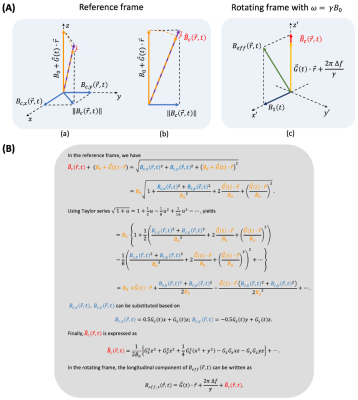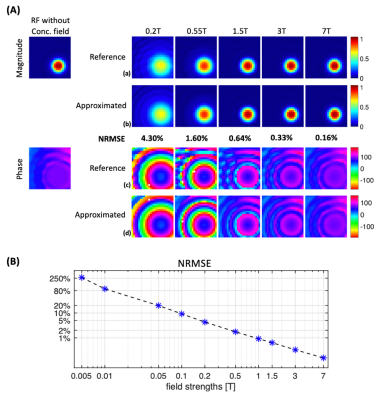Ziwei Zhao1, Nam G. Lee2, and Krishna S. Nayak1,2
1Ming Hsieh Department of Electrical and Computer Engineering, Viterbi School of Engineering, University of Southern California, Los Angeles, CA, United States, 2Department of Biomedical Engineering, Viterbi School of Engineering, University of Southern California, Los Angeles, CA, United States
1Ming Hsieh Department of Electrical and Computer Engineering, Viterbi School of Engineering, University of Southern California, Los Angeles, CA, United States, 2Department of Biomedical Engineering, Viterbi School of Engineering, University of Southern California, Los Angeles, CA, United States
We describe a multidimensional small-tip RF pulse design procedure that incorporates concomitant field effects. The proposed method produces more accurate excitation patterns, especially for low field strengths, off-isocenter, and long pulse durations.

Figure 1. Concomitant field effects approximated as a Bloch-Siegert shift. (A) Reference frame visualization of (a,b) the concomitant $$$B_c(\vec{r},t)$$$, $$$B_0$$$, and gradient field $$$\vec{G}(t)\cdot\vec{r}$$$, and Rotating frame visualization (c) showing that the $$$\tilde{B_c}(\vec{r},t)$$$ approximation can be treated as additional off-resonance in the rotating frame. (B) Detailed derivations.

Figure 2. Concomitant field estimation accuracy. (A) (left) Original 2D RF pulse excitation profile (magnitude: top & phase: bottom). (right) Magnitude (row a, b) and phase (row c, d) of the reference profiles (a, c) and estimated profiles (b, d) using Bloch-Siegert approximation at 0.2T, 0.55T, 1.5T, 3T and 7T. NRMSE results are 4.30%, 1.60%, 0.64%, 0.33% and 0.16% from 0.2T to 7T, respectively. Reference method simulates the concomitant field in the reference frame. (B) NRMSE as a function of field strength. Note that NRMSE is < 5% for B0 ≥ 0.2 Tesla.
